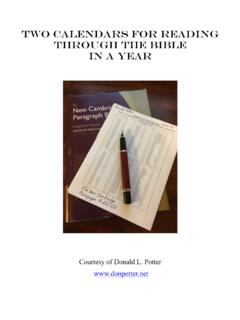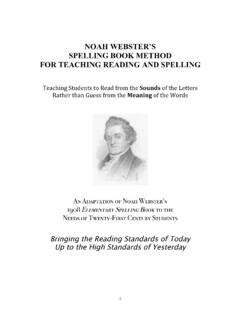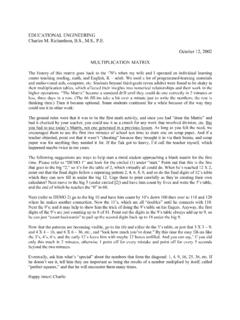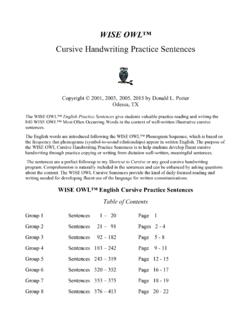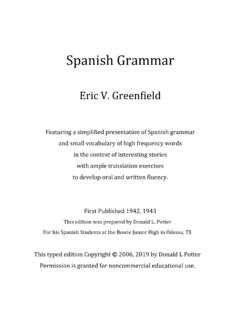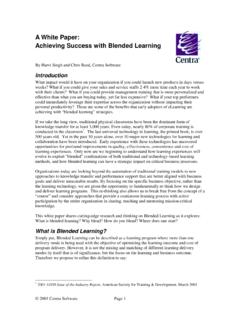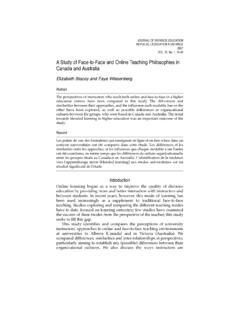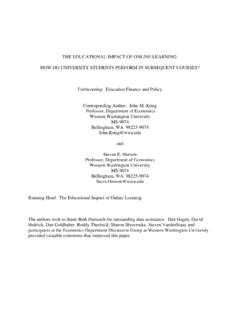Transcription of Remedial Reading Drills - Don Potter
1 Remedial Reading Drills BY THORLEIF G. HEGGE, PH. D. SAMUEL A. KIRK, PH. D WINIFRED D. KIRK, M. A. Wayne County Training School, Northville Michigan With Directions by SAMUEL A. KIRK, PH. D. Previously Published by George Wahr Publishing Co. Ann Arbor, Michigan 1965 Internet Edition for Free Distribution by Donald L. Potter Odessa, TX 2005 Previous Copyright Information: Copyright 1940, George Wahr. Reprinted: 1943, 1944, 1945, 1947, 1948, 1950, 1955, and 1963 There is a 2007 highly revised 2 vol. edition currently available: Phonics Reading Lessons: Skills and Practice Author: Samuel Kirk, Winifred Kirk, Esther Minskoff, PhD / Nancy Mather, PhD / Rhia Roberts Historical Note: There was a 1985 revision with Esther Minskoff, PhD listed as one of the authors. The 1985 editon says that the work was first published in 1936. This is also the date given in the bibliography of S. Kirk s Teaching the Slow- learning Child to Read (Houghton Mifflin Co.)
2 , 1940). DIRECTIONS The Remedial Reading Drills are designed primarily to aid children who have become retarded in Reading . In applying these exercises the Remedial teacher should first determine the status of the child and whether these exercises are applicable to his difficulties. In general, the exercises are most effective with children having the following characteristics: (1) the Reading status of the child is below the fourth grade; (2) the child has a severe special Reading disability; (3) the child is educable in sound blending; (4) any extreme visual or auditory defects have been corrected; (5) the child is motivated and cooperative. In many cases cooperation may be difficult until some degree of success has been attained. HOW TO INTRODUCE THE METHOD TO THE CHILD Before introducing the Remedial Reading Drills the teacher should spend the first few days in securing the child s cooperation, in showing him success, and in introducing the phonic method represented by the Drills to him.
3 The following suggestions may aid the teacher in achieving these aims: 1. Solicit the Child s Cooperation. For children who have failed to learn to read, the greatest incentive is showing them success at all times and especially at the beginning of training. For this reason the teacher should always aim to present the child with a task that he will master readily. It will be noted that the Drills have been constructed with this principle in mind. 2. Introduce the Method Gradually. Before Remedial training is begun the teacher should explain to the child his difficulties as well as the new method which is to be used. The following preview of the method may be used to give the child fresh hope. The child is shown the letters s, a, c, t, and p, and if he is unfamiliar with the sounds of these letters, is taught them. For example, a may be written on the board. The instructor may tell the child that when a baby cries it says a-a-a (a as in cat).
4 The letter is erased, and the child is asked to reproduce a in writing from memory, and to say a at the same time. This may be done several times. Then the child may be shown the letter s and told that it sounds like the hiss of a snake, s-s-s-s . Then the child may write s from memory and sound s at the same time. The letters s and a may be presented irregularly until the child knows both of these. Similarly, c, t, and p, are presented and worked upon until the child knows the five simple sounds. When this task is finished, the instructor may present the child with the word c a t and have the child call out sounds one at a time. He is shown that these three sounds may be blended into a word. Then the words cat, pat, tap, cap, at, sap, sat, are written on the board or on paper and the child is aided in blending these sounds and calling out the words. It should be explained to the child that because he knows the sounds of five letters he can now readily read at least seven words.
5 An explanation may follow in which the child is shown that he could start with short words and proceed to more complex words which he would soon be able to read as readily. With most children the procedure just outlined takes only a few minutes. The child now experiences success and realizes that he can learn sounds fairly easily. Even with some children of subnormal intelligence this first period is sufficient to teach the sounds of most of the consonants and of one or two vowels. Other slower learners may require a week or even two or three weeks to reach the same stage. To insure success at the outset of training the child should be presented only with tasks which he is able to master. Although simple, the pre-drill period is given as an extra precaution against any chance of failure. 3. Teach or Review the Sounds of the Short Vowel a and Most of the Consonants. During the pre-drill period the child may be told that he must sound rather than spell words.
6 He should first be taught the sound of the vowel a as described above. Consonants are introduced and taught in the same manner, emphasizing the sounds which prove difficult for the individual child. Each difficult sound may be taught in the following manner: The instructor should write the symbol t, for example, and should tell the child the sound of the symbol and associate the sound with some concrete experience of the child. A picture of teeth from a toothpaste advertisement, or the sound of a clock may aid the child to recall the sound. The child may then go to the board and write from memory the symbol t, sounding it at the same time. If it is a difficult sound he may write it several times, over and over again, saying the sound every time so as to familiarize himself with it graphically, visually, and vocally. Another consonant may be introduced and taught in the same manner. Then t may be re-introduced and alternated irregularly with the new sound, and so on.
7 If the stimulus of a game is needed, the child may be asked to find magazine pictures of objects beginning with that sound. When the sounds of most of the consonants and of the short vowel a have been taught in isolation, the next task is to train the child in the ability to blend sounds. 4. Teach Sound Blending. The next problem which is likely to present itself is the child s inability to blend sounds. In some cases the acquisition of this ability requires considerable attention. At first the child is shown by verbal demonstrations that c-a-t (sounds not letters) say cat. Usually the child may learn by following the instructor on several words. It is essential, of course, to give each letter the sound exactly as found in the word, avoiding any superfluous sound, such as the vocal additions often put at the end of the isolated sounds of b, k, p, (buh, kuh, puh) or at the beginning of m, n, l, r, etc.
8 If some difficulty arises in blending the sounds into a word, the instructor may have to devote some time to this type of practice. The following methods are suggested: First, write the words c a t, s a t, m a t, on the board and have the child sound each letter in isolation. At first the child should be allowed to vocalize the letters at his own rate of recall, then to repeat the sounds a little faster, then still faster until the blend is made. In other words, the child may be asked to sound the sequence of letters several times at an increasing rate. This procedure may be necessary at first until the child is able to blend the sounds into a word fairly well. If this method does not produce results the following method may be tried. After the instructor has written a number of words, such as c a t, m a n, s a t, r a t, b a t, l a p, s a p, m a p, and has aided the child in blending the sounds he may then dictate the words as wholes to the child by telling him to write, for example, the word cat.
9 If he does not know how to start he may be asked to say cat, and then asked to tell with what sound the word cat starts. He may then say and write the sound c. Then what is the next sound? (demonstrate) cat, c-a-t, etc. In brief, allowing the child to dissect words and analyze their parts, then to write them from dictation while saying them will aid him in blending sounds. Another device may be used as a variation from the other two. The child may sit with his back to the instructor and the instructor may sound words of two sounds at first, then of three sounds, and then of four sounds. For example, the instructor may first say, what word is m-ay, sh-e, b-e, etc. (sounding each element separately). If the child is able to call out these words, increase the sounds to three letters such as b-a-d, s-a-t, etc. Another variation of this device is first to sound m-e, very rapidly. Then the word m-e may be said more slowly until there is a definite break between the sounds.
10 The sounds may be given at the rate of two per second, and the time interval may be increased to one sound per two or three seconds, for both two and three letter words. When the child knows the sounds of most consonants and the sound of the vowel a, and is able to blend three sounds into a word (even inadequately or slowly) he is ready to begin practicing in the Remedial Reading Drills . DIRECTIONS FOR Remedial INSTRUCTION The following directions are given to aid the teacher in the use of the Remedial Reading Drills and supplementary exercises: 1. Always Begin with Drill 1. After the initial training period the child should be ready for Drill 1. Allow the child to read this drill at his own rate. If it seems too easy for him, remember that success on it is another stone in building confidence. 2. Teach the Child to Respond to Individual Symbols. Although many systems of phonics prefer combining the vowel with the last consonant, the Remedial Reading Drills should be read as indicated by the spacings, one letter at a time, sounding out c-a-t, cat, m-a-t, mat, etc.

